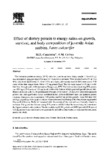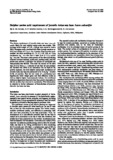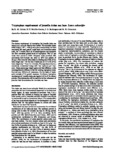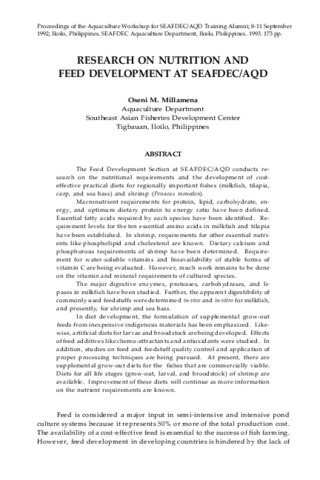Effect of dietary protein to energy ratios on growth, survival, and body composition of juvenile Asian seabass, Lates calcarifer
Share
Abstract
The optimum protein-to-energy (P/E) ratio for juvenile sea bass (body weight, 1.34 ± 0.01 g) was determined using practical diets in a 3 × 3 factorial experiment. Three protein levels (35, 42.5 or 50%) and three lipid levels (5, 10 or 15%) at a fixed carbohydrate level of 20% were tested. P/E ratios of the diets ranged from 104 to 157 mg protein/kcal. The fish were reared for 54 days in 60-liter flow-through tanks with seawater at 32 p.p.t. and 29 °C. Fish fed the diet containing 50% protein and 15% lipid (P/E ratio of 125 mg/kcal) showed the highest weight gain and specific growth rate. Those fed the diet with 42.5% protein and 10% lipid (P/E ratio of 128 mg/kcal) showed comparable growth rate and significantly better condition factor, protein efficiency ratio and apparent protein retention. Fish given diets containing 35% protein showed the poorest growth. Those fed diets with 5% lipid regardless of the protein content showed abnormal reddening of the fins, indicating essential fatty acid deficiency. Body fat increased with fat content of the diet and was inversely related to moisture. Fish given the diet containing 35% protein and 5% fat had the lowest body fat content and the highest ash and water content. The diet containing 42.5% protein and 10% lipid with P/E ratio of 128 mg protein/kcal was found to be optimum for juvenile seabass under the experimental conditions used in the study.
Suggested Citation
Catacutan, M. R., & Coloso, R. M. (1995). Effect of dietary protein to energy ratios on growth, survival, and body composition of juvenile Asian seabass, Lates calcarifer. Aquaculture , 131(1-2), 125-133. https://doi.org/10.1016/0044-8486(94)00358-U
Subject
Taxonomic term
Collections
- AQD Journal Articles [1249]
Related items
Showing items related by title, author, creator and subject.
-
Sulphur amino acid requirement of juvenile Asian sea bass Lates calcarifer
Coloso, Relicardo M.; Murillo-Gurrea, D.P.; Borlongan, Ilda G.; Catacutan, Mae R. (John Wiley and Sons, 1999)The dietary requirement of juvenile Asian sea bass Lates calcarifer for total sulphur amino acids was studied. Fish (average initial weight of 2.59 plus or minus 0.08 g) were reared in twelve 500 L fibreglass tanks provided ... -
Tryptophan requirement of juvenile Asian sea bass Lates calcarifer
Coloso, R. M.; Murillo-Gurrea, D. P.; Borlongan, I. G.; Catacutan, M. R. (Blackwell Publishing, 2004)The dietary requirement of tryptophan for juvenile Asian sea bass (Lates calcarifer Bloch) was studied. The juveniles (mean initial weight, 5.30 ± 0.06 g) were given semi-purified test diets containing fish ... -
Research on nutrition and feed development at SEAFDEC/AQD
Millamena, Oseni M. (Aquaculture Department, Southeast Asian Fisheries Development Center, 1993)The Feed Development Section at SEAFDEC/AQD conducts research on the nutritional requirements and the development of costeffective practical diets for regionally important fishes (milkfish, tilapia, carp, and sea bass) and ...




